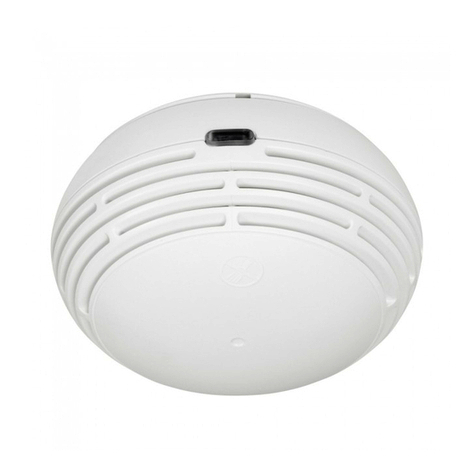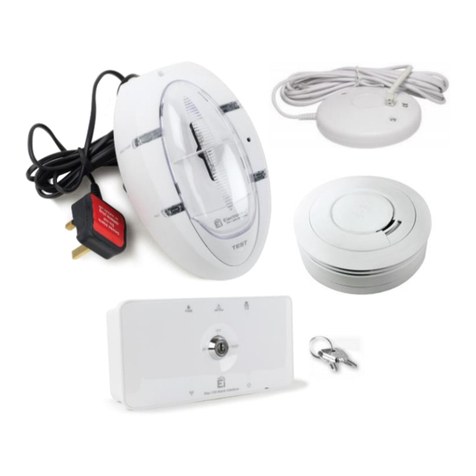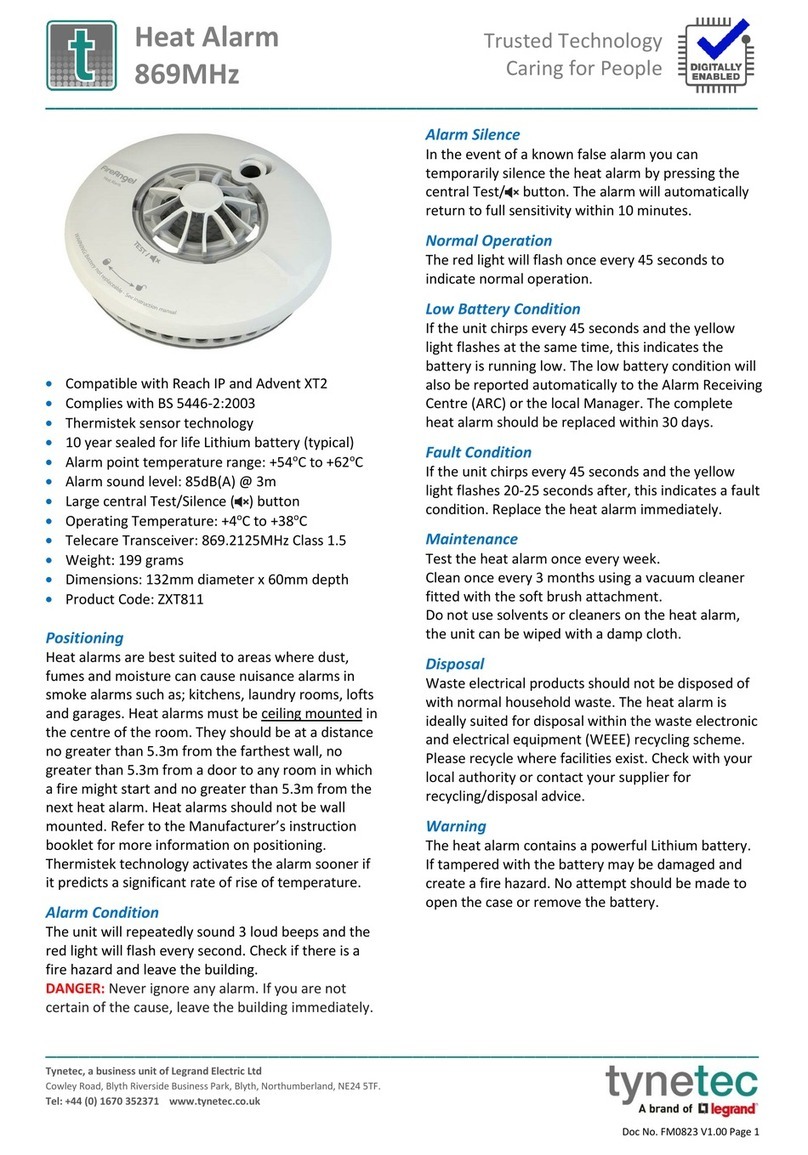The Limitations of Smoke Alarms:
n Smoke alarms cannot provide an alarm if smoke does not reach the alarm.
Therefore, smoke alarms may not sense fires starting in chimneys, walls,
on roofs, on the other side of a closed door, or on a different floor.
n If the alarm is located outside the bedrooms, or on a different floor, it may
not wake up sound sleepers. A smoke alarm in the bedroom, is therefore
recommended as additional protection.
n Smoke alarms have been significant in saving lives in many parts of the
world. However, U.S. Government research indicates that they may not
give early enough warning in up to 35% of fires. Hence, the use of this
product does not act as a substitute for basic prevention.
n Although smoke alarms can help save lives by providing early warnings of
a fire, they are not a substitute for an insurance policy.
n This smoke alarm alone will not alert the hearing impaired. Use special
purpose smoke alarm with lights or vibrating devices, for those hard of
hearing.
Develop and Practise a Plan of Escape:
n Make a floor plan indicating all doors and windows and at least two
escape routes from each room. Second storey house windows may need
a rope or chain ladder.
n Have a family meeting and discuss your escape plan, showing everyone
what to do in case of fire.
n Determine a place outside your home where all of you can meet, if a fire
occurs.
n Familiarise everyone with the sound of the smoke alarm and practice
leaving your home when they hear it.
n Practice a fire drill at least every six months, including drills at night.
Practice allows you to test your plan before an emergency. You may not
be able to reach your children. It is important that they know what to do!
What to do when the Alarm Sounds:
n Leave immediately by your plan of escape. Every second counts, so don’t
waste time getting dressed or picking up valuables.
n In leaving, don’t open any inside door without first feeling its surface.
If hot, or if you see smoke seeping through cracks, don’t open that
door! Instead, use your alternative exit. If inside door is cool, place your
shoulder against it, open it slightly and be ready to slam it shut if heat and
smoke rush in.
n Stay close to the floor if air is smoky. Breathe shallowly through a wet
cloth if possible.
n Once outside, go to your selected meeting place and make sure everyone
is there.
n Call the Fire Brigade from your neighbour’s home - not from yours!
n Don’t return to your home until officials say that it is safe to do so. For
additional information on fire safety, contact your local Fire Brigade.
This smoke alarm has a maximum 10 year life span. THIS SMOKE ALARM HAS BEEN TESTED AND PASSED TO AS3786-1993
DEAR ELECTRICIAN: PLEASE LEAVE THIS MANUAL FOR THE OWNER. THANK YOU FOR CHOOSING THIS SMOKE ALARM.
PROFESSIONAL IONISATION / PHOTOELECTRIC SMOKE ALARM
INSTALLATION INSTRUCTIONS
Warranty
HPM Legrand will honour all statutory guarantees that you as a consumer
are entitled to rely upon under the Australian and New Zealand Consumer
Laws against a manufacturer including a guarantee that any products
HPM Legrand has manufactured or imported are of acceptable quality.
To make a claim under any statutory guarantee (or other warranty) you
should first contact the supplier, contractor or retailer from whom you
purchased the products.
Customer Service
For all Customer Service and Technical Support enquires please call
Monday to Friday during business hours.
HPM Legrand Australia
1300 369 777
www.legrand.com.au
HPM Legrand New Zealand
0800 476 009
www.legrand.co.nz
ABN: 31 000 102 661
LE05841AAC
Disclaimers:
1. This product must be installed by a licenced electrician.
2. For indoor use only
3. This product should not be installed in areas exposed to constant vibration,
temperature fluctuations, or areas of high humidity.
4. This product contains no serviceable parts and no attempt should be made to
repair this product. If the product is faulty it should be discarded.
5. Severe electromagnetic interference from other products may cause
malfunction of this product.
6. Ionisation smoke alarms contain radioactive particles. Please refer to
instructions for disposal requirements.
7. This product has a 10 year design life. At the end of this time it should be
replaced. The date of Manufacture is coded on every alarm in the form
B/N 15 March 2013.
8. This product has been designed to operate in ambient temperatures:
5°C to 50°C.
9. This product is not suitable for marine environments such as areas subject to
salt spray and/or mist.
10. This product is not suitable for installation in hazardous and/or corrosive areas.
11. This product has been designed for domestic or similar uses and is not suitable
for a commercial installation.
12. The material in this product may vary in colour from batch to batch. Colour
matching from one batch to another cannot be guaranteed.
13. Electrical installations periodically receive transient over voltages. This product
has been designed to minimise the effect of such voltages on connected
equipment. It may not give full protection for extreme over voltage transients
such as those resulting from a close lighting strike.
14. This product has been designed to operate on a nominal supply voltage of
230V - 240V a.c. ± 6%.
15. This product must be installed and used as per these instructions.
16. After installation this product must be tested as required by the appropriate
government and/or staturatory regulations.
17. This product utilises intellectual property in the form of registered designs,
trademarks, and/or patents. Such intellectual property remains the property of
HPM Legrand in all cases.
18. HPM Legrand reserves the right to modify the specification of this product at
any time.
False Alarms:
n In very humid areas or near a bathroom, moisture can cause false alarms
in Ionisation smoke alarms.
n This smoke alarm is designed to minimise false alarms. Smoking will not
normally set off the alarm unless smoke is blown directly into the alarm.
n Combustion particles from cooking may set off the alarm if the alarm is
located close to the cooking surface.
n Because large quantities of combustion particles are generated from
spills or grilling an alarm with a Hush Control device is preferable near a
kitchen environment.
n If the alarm does sound, check for a fire before silencing the alarm. If a fire
is discovered, escape quickly and call the Fire Brigade.































